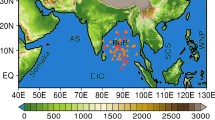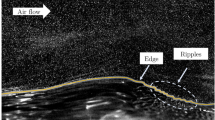Abstract
Surface cyclone tracks are investigated in the context of moist potential vorticity (MPV). A prognostic equation of surface absolute vorticity is derived which provides a basis for using negative MPV (NMPV) in the troposphere as an alternative approach to track surface cyclones. An observed case study of explosive lee cyclogenesis is performed to test the effectiveness of the MPV approach. It is shown that when a surface cyclone signal is absent due to the blocking of the Rocky Mountains, the surface cyclone can be well identified by tracing the peak NMPV.
Similar content being viewed by others
References
Blackmon, M. L., J. M. Wallace, N.-C. Lau, and S. L. Mullen, 1977: An observational study of the Northern Hemisphere wintertime circulation.J. Atmos. Sci.,34, 1040–1053.
Blender, R., K. Fraedrich, and F. Lunkeit, 1997: Identification of cyclone-track regimes in the North Atlantic.Quart. J. Roy. Meteor. Soc.,123, 727–741.
Bond, N. A., and R. G. Fleagle, 1985: Structure of a cold front over the ocean.Quart. J. Roy. Meteor. Soc.,111, 739–759.
Cao, Z., and H.-R. Cho, 1995: Generation of moist potential vorticity in extratropical cyclones.J. Atmos. Sci.,52, 3263–3281.
Cao, Z., and G. W. K. Moore, 1998: A diagnostic study of moist potential vorticity generation in an extratropical cyclone.Adv. Atmos. Sci.,15, 152–166.
Carnell, R. E., and C. A. Senior, 1998: Changes in midlatitude variability due to increasing greenhouse gases and sulphate aerosols.Climate Dyn.,14, 369–383.
Davis, C. A., and K. A. Emanuel, 1991: Potential vorticity diagnosis of cyclogenesis.Mon. Wea. Rev.,119, 1929–1953.
Gyakum, J., D.-L. Zhang, J. Witte, K. Thomas, and W. Wintels, 1996: CASP II and Canadian cyclones during the 1989–92 cold seasons.Atmos.-Ocean,34, 1–16.
Hoskins, B. J., M. E. McIntyre, and A. W. Robertson, 1985: On the use and significance of isentropic potential vorticity maps.Quart. J. Roy. Meteor. Soc.,111, 877–946.
Hu, Q., and E. R. Reiter, 1987: A diagnostic study of explosive cyclogenesis in the lee of the Rocky mountains.Meteor. Atmos. Phys.,36, 161–184.
Huo, Z., D.-L. Zhang, and J. Gyakum, 1998: An application of potential vorticity inversion to improving the numerical prediction of the March 1993 superstorm.Mon. Wea. Rev.,126, 424–436.
Lau, N.-C., 1988: Variability of the observed midlatitude storm tracks in relation to low-frequency changes in the circulation pattern.J. Atmos. Sci.,45, 2718–2743.
Lewis, P. J., 1987: Severe storms over the Great Lakes: A catalogue summary for the period 1957 to 1985. Canadian Climate Center Rep. 87-13, Meteorological Service of Canada, Downsview, ON, Canada, 342pp. [Available from Climatological Services Division, Meteorological Service of Canada, 4905 Dufferin St., Downsview, ON M3H 5T4, Canada.]
Mass, C. F., and D. P. Dempsey, 1985: A one-level, mesoscale model for diagnosing surface winds in mountainous and coastal regions.Mon. Wea. Rev.,113, 1211–1227.
Petterssen, S., 1956:Weather Analysis and Forecasting. Vol. 1, McGraw-Hill, 428pp.
Serreze, M. C., 1995: Climatological aspects of cyclone development and decay in the Arctic.Atmos.-Ocean,33, 1–23.
Thorpe, A. J., and S. A. Clough, 1991: Mesoscale dynamics of cold fronts: Structures described by dropsoundings in FRONTS 87.Quart. J. Roy. Meteor. Soc.,117, 903–941.
Wallace, J. M., G.-H. Lim, and M. L. Blackmon, 1988: On the relationship between cyclone tracks, anticyclone tracks and baroclinic waveguides.J. Atmos. Sci.,45, 439–462.
Wu, G., and H. Liu, 1997: Vertical vorticity development owing to down-sliding at slantwise isentropic surface.Dyn. Atmos. Oceans,27, 715–743.
Zhang, D.-L., and H.-R. Cho, 1992: The development of negative moist potential vorticity in the stratiform region of a simulated squall line.Mon. Wea. Rev.,120, 1322–1341.
Author information
Authors and Affiliations
Corresponding author
Rights and permissions
About this article
Cite this article
Cao, Z., Zhang, DL. Tracking surface cyclones with moist potential vorticity. Adv. Atmos. Sci. 21, 830–835 (2004). https://doi.org/10.1007/BF02916379
Received:
Revised:
Issue Date:
DOI: https://doi.org/10.1007/BF02916379




